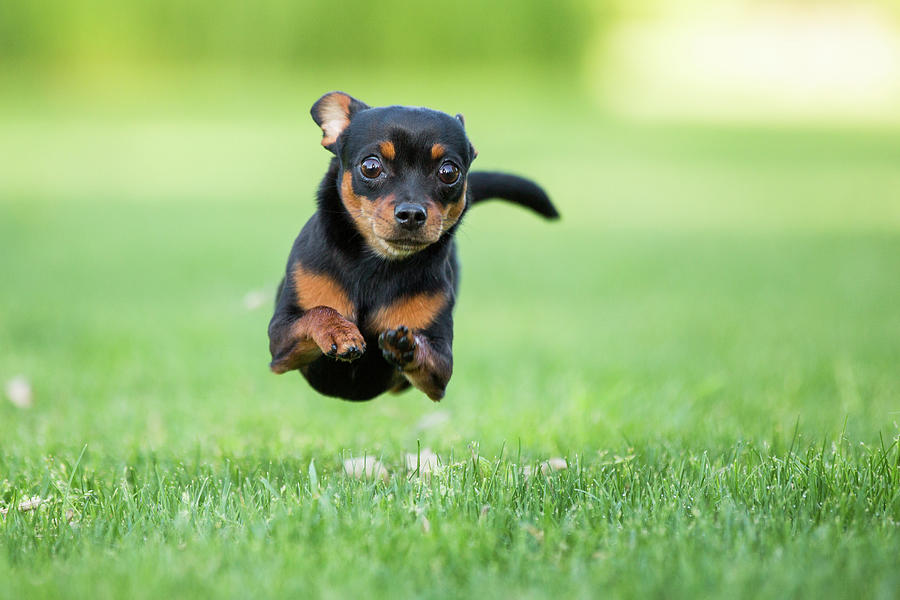How fast can a Chihuahua run?
In this article, I’m going to reveal the answer.
Continue reading to discover:
- Three simple tips for training your Chihuahua to be a stronger runner.
- Reasons why your Chihuahua might run slow (+ ways to solve it).
- The fastest speed a Chihuahua can run (and the average running rate).
- And more…
How fast can a Chihuahua run?
Chihuahuas can run anywhere between 8mph and a maximum of 21mph. Many factors, including diet and body size, can influence where they fall on this spectrum. Although it’s not quite possible to breed faster Chihuahuas, you can train your pup to be a more robust, faster-running pup with consistent practice.
That being said, let’s talk about…
What is the fastest a Chihuahua can run?
Humans have been timing the running speed of dogs for several decades now. Yet, most studies focus on Greyhounds, German Shepherds, and other large working or sporting breeds.
Based on the dogs tested in the past, we know that the average dog can run at about 19mph (30kph). This number for Chihuahuas and other toy companion breeds typically drops a bit.
But why? Chihuahuas’ legs are much smaller than most other breeds. So, even if they move their legs just as quickly as a Shepherd or Retriever, they don’t quite have the same reach.
Still, some Chihuahuas have defied the laws of short legs and physics by reaching unimaginable speeds.
One unnamed Chihuahua excitedly demonstrated his competitive racing edge when chasing his owner on a motorcycle.
When observing the speedometer on the bike, it was clear that the pup got up to an unbelievable 21mph (35kph)!
Still, this portrays only one end of the spectrum of Chihuahua running speeds. Not all dogs of this adorable breed can achieve such swiftness.
Most Chihuahuas can match the speed of YouTube’s beloved Nacho. In a test to show the world what she’s got, Nacho zoomed across a football field to the 20-yard line in about five seconds.
(That’s the equivalent of running 8 miles per hour or 12 kilometers per hour.)
Though it’s not quite record-breaking, Nacho’s performance is a reliable representation of the speed most Chihuahuas can run.
Limits to Chihuahuas’ running abilities
If some Chihuahuas can reach speeds of 21mph while others are stuck at eight mph, it’s easy to wonder what their physical limits may be.
In 1982, researchers learned that dogs’ bodies have biological safety mechanisms to keep them from running too quickly.
Think about it. Your bones (and your dog’s bones, too) have evolved to help your body move around. But they are also meant to keep the body from overextending muscles.
As an animal speeds up, its gait changes, resulting in locomotion patterns that impose different levels of strain and pressure on the body.
Watch your dog the next time they run. You’ll notice that their legs extend farther out than when they are leisurely trotting around the house.
With each extension and withdrawal of the legs, a force is known as the ‘bone load’ is placed on the bone. The bone load is comprised of:
- Axial force. The power of the tension exerted on the leg.
- Bending moment. The point at which the leg bends during movement.
- Torsion. The forces exerted on the portion by twisting or turning.
Because Chihuahuas’ legs are so small, they can’t take as much of these gravitational forces as larger breeds can. These forces grow in intensity when they run, which limits their overall movement.
These physical pressures can slow down even the fastest of these little companions. (This is why Nacho and other fast Chis can only run so fast in short bursts, and they’re not made for extended high-speed running!)
More reasons why your Chihuahua may be running slowly

Just like you and I, dogs require a certain amount of energy and rest to give their best performance in physically-demanding activities.
Surprisingly, scientists have learned that age is not closely related to a dog’s nutritional needs. So, unless they are sick, older dogs may not need a different diet than younger adults to reach their top speed.
Furthermore, there are no specific differences in the nutritional necessities between one breed size versus another.
However, there may be significant differences in how they digest food because of the shorter digestive tract in toy breeds.
To avoid any potential problems with this, always allow your dog to rest for at least thirty minutes before exercising.
To boost your Chihuahua’s energy levels, and help them pick up the pace, make sure their diet abides by the table below:
| Calories per Day | General Guidelines | Specific Percentages | Required Vitamins | Necessary Minerals |
|---|---|---|---|---|
| 404kcal | 25g Crude Protein 14g Total Fat | 50% Carbohydrates 2.5-4.5% Fiber 5.5% Fat 10% Protein | Vitamin A, D, E, K, B6, B12 Thiamin Riboflavin Niacin Pantothenic Acid Folic Acid Choline | Calcium Phosphorus Magnesium Sodium Chlorine Iron Copper Zinc Manganese Selenium Iodine |
Can you breed or train Chihuahuas to be faster?
If the average Chihuahua can only reach eight mph, but others have set astonishing records, is it possible to make the breed faster?
A 2008 study looked into this question as the researchers pondered the possibility of breeding all-new generations of speedier canine companions.
By using data from Greyhound races over 460-480m (about 1/3 of a mile) distances, they discovered the following:
- The maximum speeds of dogs leveled off after about five years of racing and breeding.
- The speeds of dogs today are hardly any higher than they were 40-60 years before.
- Dogs have not naturally evolved to become faster and are unlikely to do so in the foreseeable future.
There is a ‘but’ to this story, though. The researchers did learn that humans can breed faster dogs.
It is also possible to train your Chihuahua to be a stronger runner. Past studies have shown that coordination and consistent cyclical movements contribute positively to a dog’s speed.
This means that with regular training sessions, you could potentially help your Chihuahua to become a more efficient runner. So, how do you do it?
How to train your Chihuahua to be a stronger runner

Your Chihuahua’s health should always come first as you teach them to improve their running skills. Before you get started in your exercise sessions, make sure to get them evaluated by a veterinarian.
Patellar luxation (PT) is a widespread joint disease among small dogs, including Chihuahuas. Although PT won’t permanently harm their running, it can be painful for your pup.
Have the vet check your dog for other joint problems, such as hip dysplasia and arthritis. These conditions are more prevalent in older dogs and may even coincide with heart problems.
When your Chihuahua’s check-up is complete, follow the tips below:
#1: When out for a run, choose dirt or grass paths rather than concrete or asphalt.
The natural surfaces are much easier on your dog’s joints.
(Still, be wary of surprise rabbit and gopher holes, sharp rocks, and uneven terrain! Natural pathways are not entirely risk-free.)
#2: Exercise during the more excellent parts of the day.
You should set out during the hours of the early morning or evening.
This is especially important where there are few or no areas to run apart from asphalt or concrete.
These surfaces heat up tremendously and can hurt your Chihuahua’s feet! Cooler temperatures will also allow you to run over a longer distance.
#3: If your dog is not yet comfortable running, start practicing by alternating between walks and brief running sessions.
As they get used to the activity, increase the distance and speed each week. Make sure the change is gradual.
You should increase the distance between 5-10% weekly to achieve the desired improvement safely.
Remember to let your dog have fun with these practice sessions! Morning or evening jogs should be a time to bond with your Chihuahua.
Please don’t push your Chi so hard that you lose focus on their health and happiness. Even if they only run at the average small-dog-sprint of 8mph, your Chihuahua is a champion and should be cherished!




